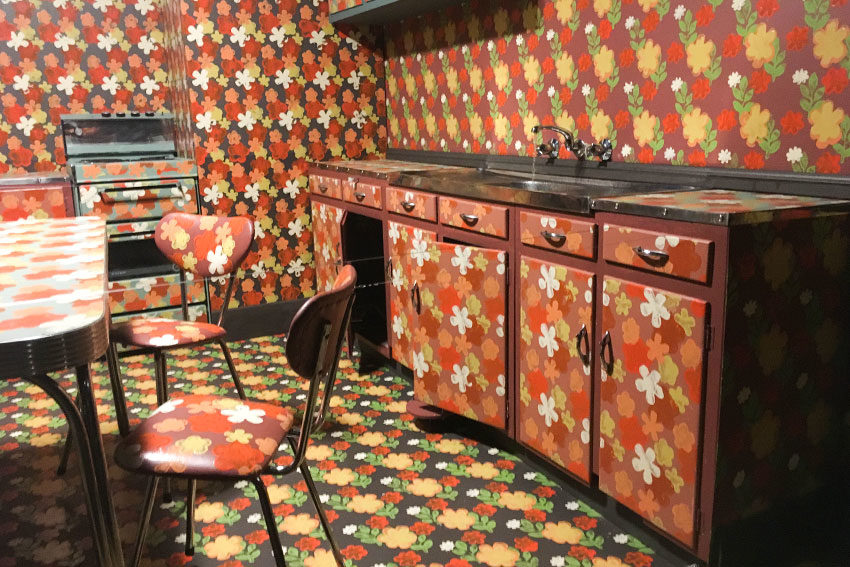Nicholas Folland’s creative kitchen

As Adelaide embraces another SALA Festival, a sense of cultural history and an ability to put on a show combine to make a work both complex and ambitious in its ordinariness.
Is Nicholas Folland the quintessential South Australian artist? Heaven forbid. What an albatross to hang around anyone’s neck. And yet. I came across a piece of Barbara Hanrahan writing the other day – “What we want now in Adelaide are writers and artists who work from the heart of those common-place suburban streets, who recognise the weirdness of the ordinary, who record it before the version of it we have now is swept away.” – and thought of Folland’s work. Not all of it, but its overall tone.
To get into Folland’s world one has to have a sense of cultural history, particularly of the role that the artefact (preferably in the Adelaide tradition of being well designed) plays in creating a sense of ‘here’ and ‘there’. At the time of writing, the artist is bent to the task of producing what promises to be his most complex and ambitious work to date. And that’s saying something because this artist knows how to put on a show. Consider his spectacular 2012 installation, Untitled (Jump Up), in the Art Gallery of South Australia’s Elder Wing composed of multiple crystal and glassware vases, bowls and the like, massed to create ‘islands’ suspended above the floor. Another work, Raft 1 (2005), an early example of the artist’s large-scale object-based installations, consisted of a tilted bathroom with water spilling from overflowing hand bowl and bath.
In these and other works, Folland’s theatrical instincts and experience offered multiple points of engagement for viewers. Raft in particular presented as a theatre set sans actors. Other Homes and Gardens, installed at Adelaide Central Gallery for SALA draws on the experience and content of these and another work, Field, installed in McClelland Gallery in 2005 – essentially a wall laid on its side, colonising the narrow gallery space.
Other Homes promises an immersive experience, similar but quite different to any of Folland’s installation works to date. The entire gallery, apart from narrow viewer access corridors and limited viewpoints, will be occupied by a kitchen of sorts. This space, with a table and chairs and some cupboards and doors sits as a ‘gallery within a gallery’.
This device was employed to some degree in Raft but emphatically so in Other Homes, where the viewer is ‘looking in’ on a room, in much the same way people tour heritage houses, able to peer but held in check by see-through panels. Anyone who has experienced the Margaret Olley ‘house and studio’ installation at Tweed River Regional Gallery will get the picture.

The trope of creating an alternate world within a dedicated art space has extensive form through the modern era, including such well-known examples as Kurt Schwitters’ Merzbau (1933), Allan Kaprow’s late 1950s environments and Ilya Kabakov’s fictional Moscow apartment, The Man Who Flew into Space (1988).
There are two very active ingredients in Folland’s kitchen. All the surfaces are crawling with repeat patterns that can be best described as ‘viral pumpkin’. A team of helpers has been covering walls, chairs and table top with floral patterns produced by stamping inked up pumpkin shapes. The effect is visual overload – as if in a feverish 1960s retro trip where the world is overrun with toxic floral fungi.
The other active element is that things move. The table, chairs, cupboards and doors are activated by visible motors to do the shimmy. If this doesn’t get you thinking about the 1980s film series The Brave Little Toaster (a group of dated appliances embarks on a journey to the city to find its master after being abandoned in a cabin in the woods) then nothing will. Folland says that he has been recently coming off some heavy-duty planning associated with an installation at The National in Sydney and sees Other Homes as an opportunity to loosen up a little. So, in true paranormal tradition, things move mysteriously and doors creak and bang.
Lots of fun, but with Folland there is always a gravitas. In this work it takes the form of “a sense”, as he describes it, “that there might be something a bit more than unnerving about a space that has familiar elements … by hyping up elements, like the wallpaper and movement of things… hopefully it will create a sense of searching within the space for some logic. But it also defies a kind of logic”.
One of Folland’s most persistent themes has been the question of nature versus culture. He says that he is always “interested in the way we invite nature into our homes”. More recently he observes that this need to “bring it in” has intensified, perhaps as an expression of a yearning for a time when humanity was closer to the soil. The irony, and tragedy, of this yearning is a possible reading of Other Homes where an excess of nature in the form of over-the-top flower patterning on artificial surfaces (aided and abetted by wobbly furniture) underscores the instability of that relationship. “I hope you go home,” Folland says, “to see your walls move.”
Nicholas Folland: Other Homes and Gardens
Adelaide Central School of Art
July 31 – August 30
Header image:
Adelaide Central School of Art